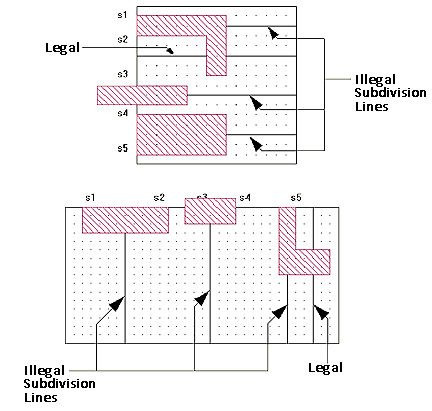You select Insert - Subdivider to place subdividers in your circuit in preparation for dividing your circuit into subprojects. This process is referred to as circuit subdivision. Subdivision is used to analyze a large geometry project for which you wish to reduce the memory requirements and processing time. Subdividing allows you to analyze smaller circuits in much less processing time and at fewer frequencies. Analysis of the automatically created netlist can take advantage of interpolation to produce data for more frequencies than are available from the individual subprojects. The subdivision is performed when you select Circuit - Subdivide Circuit.
![]() For a more detailed description of circuit subdivision, see Circuit Subdivision in the Sonnet User's Guide.
For a more detailed description of circuit subdivision, see Circuit Subdivision in the Sonnet User's Guide.
Selecting this command allows you to add one subdivider to your circuit before reverting back to pointer mode. If you wish to add multiple subdividers, hold down the shift key or click on the Pin mode button in the Insert tool bar when selecting the command.
You may enter the location of the subdivider using the keyboard, see Keyboard Entry of Points and Polygons for details.
All subdividers must have the same orientation, either horizontal (left-right) or vertical (up-down). This orientation is selected in the Subdivider Orientation dialog box. This dialog box is opened when the Add Subdivider command is selected when no subdividers are present in the circuit. If you wish to change the orientation of your subdividers, you should select all subdividers in your circuit, then delete them. Once all the subdividers have been removed, select Insert - Subdivider. This opens the Subdivider Orientation dialog box again in which you can select the other orientation for your subdividers.
Once the orientation of the subdividers has been chosen, the project editor enters Add Subdivider mode, indicated by a change in the cursor. Click on the desired location in your circuit where you wish to subdivide your circuit. A subdivider appears through that point in the direction of the selected orientation and a section label appears in each section of the circuit. Subdivision sections are labels ''s1'' ''s2'' ''s3'' and so forth, from left to right for vertical subdividers, and top to bottom for horizontal subdividers. These are added automatically and may not be edited. If you add a subdivider between two existing subdividers, all sections in the circuit are renamed in sequential order.
A subdivider is used to specify the place or places at which you wish you split your circuit when performing a circuit subdivision. All subdividers must have the same orientation, either horizontal (left-right) or vertical (up-down).
Subdivision sections are labeled ''s1'' ''s2'' ''s3'' and so forth, from left to right for vertical subdividers, and top to bottom for horizontal subdividers. These are added automatically and may not be edited. If you add a subdivider between two existing subdividers, all sections in the circuit are renamed in sequential order.
You should be aware of the following about subdividers:
The following are illegal conditions for subdivision lines:
